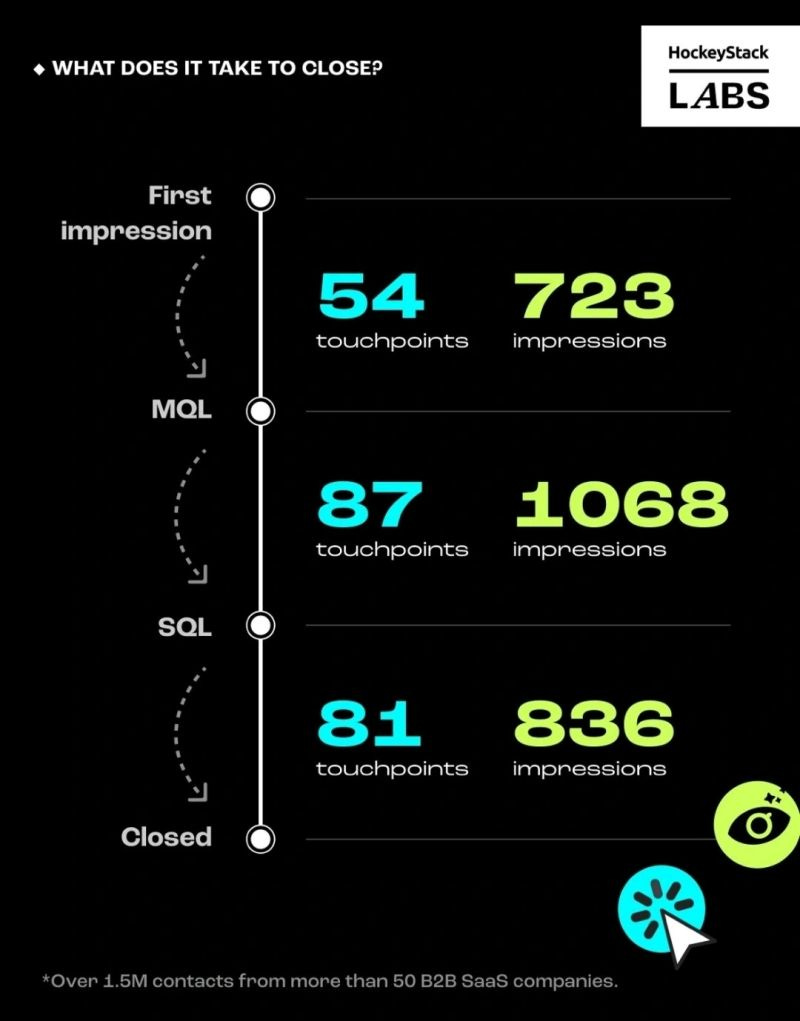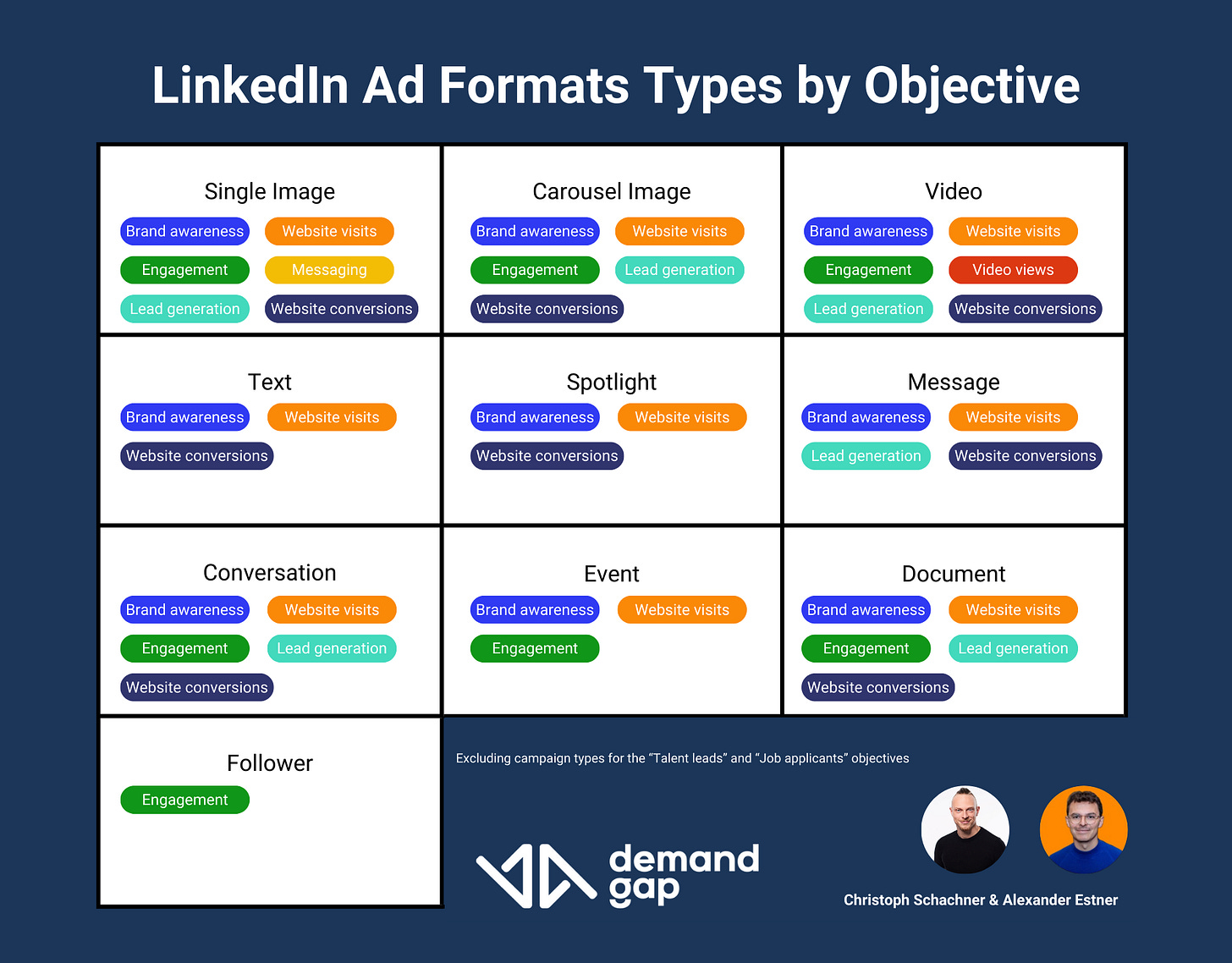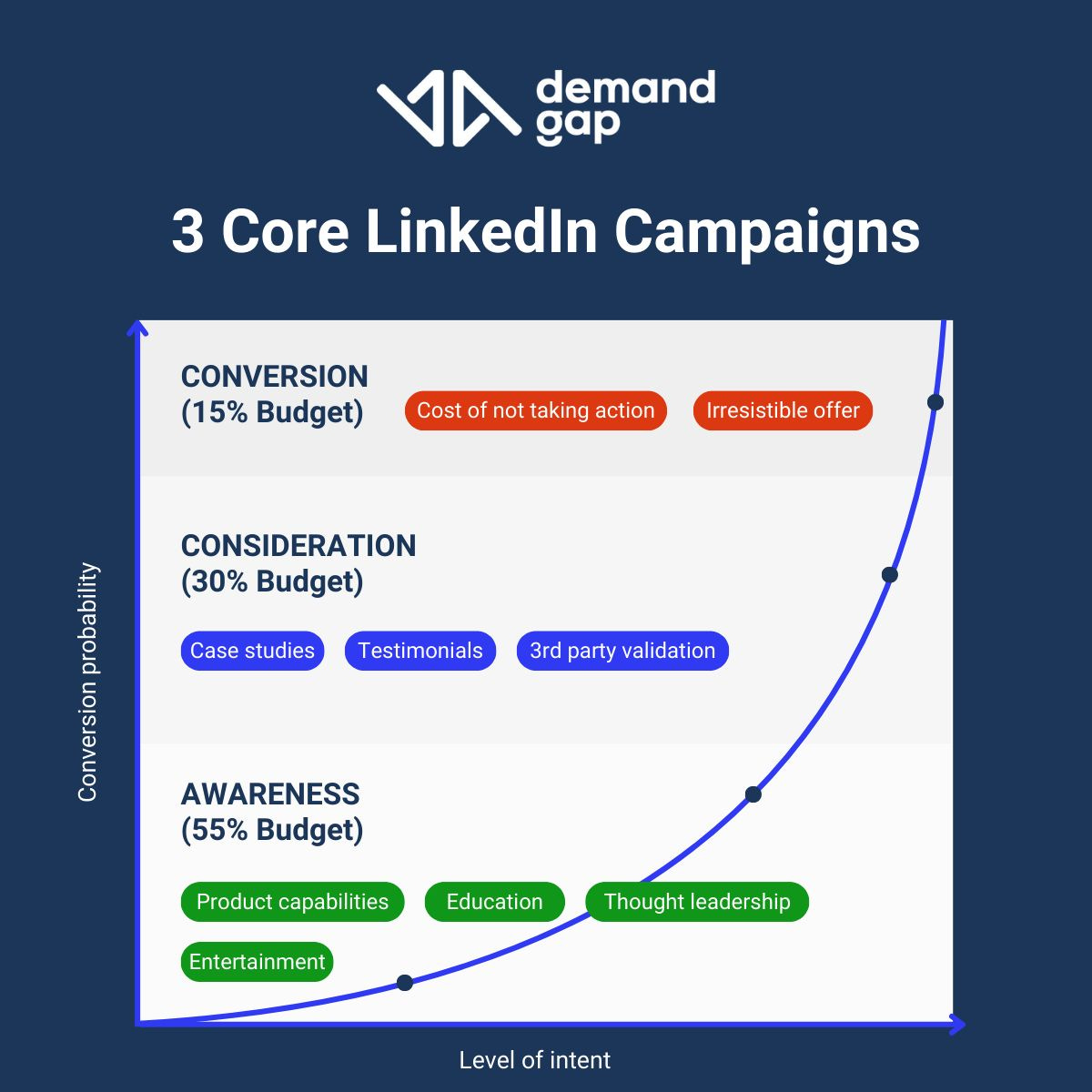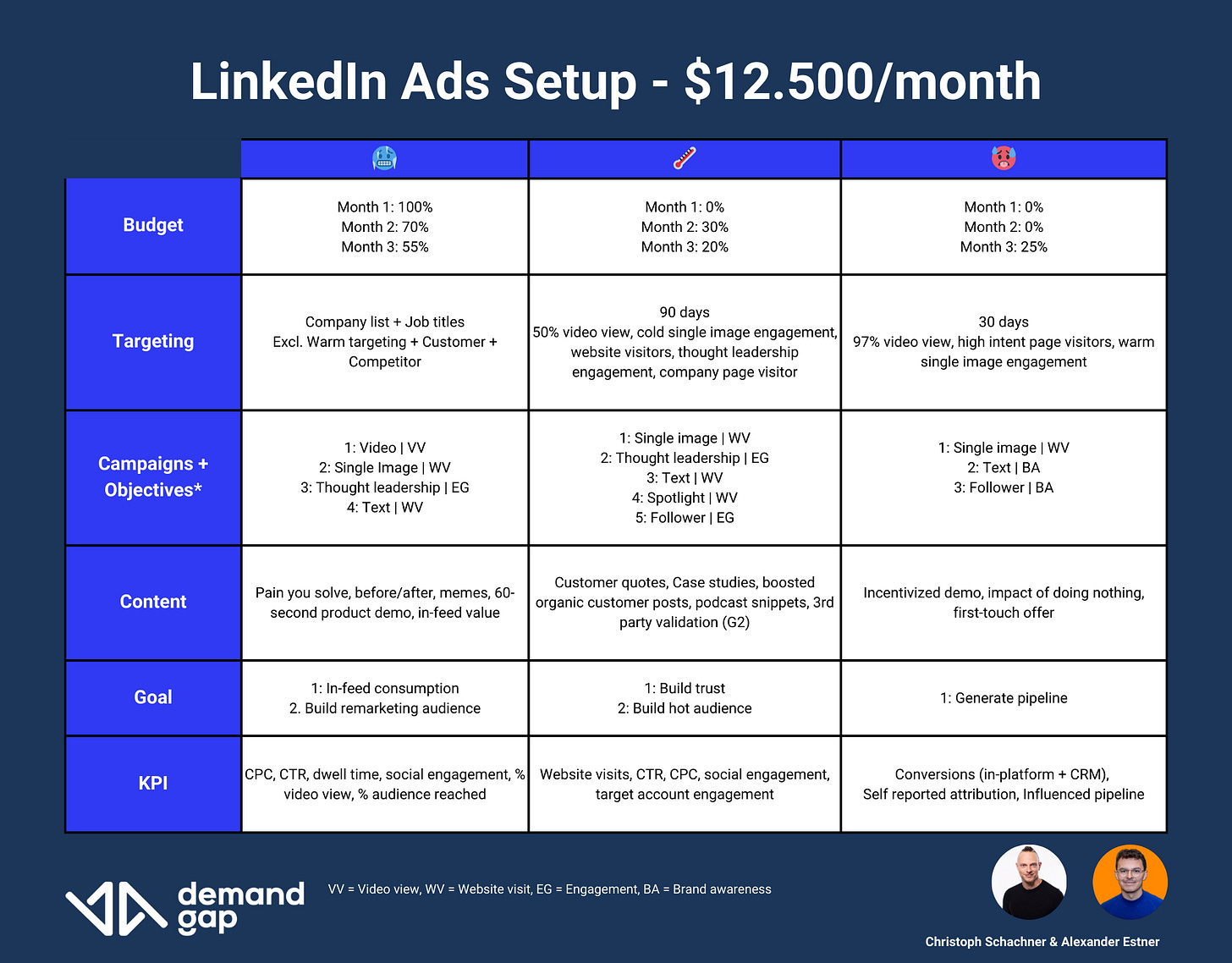How to get started with LinkedIn Ads for early-stage B2B SaaS startups
Hey - it’s Alex - this time together with Christoph Schachner!
Today we cover:
1️⃣ The 10-point checklist if LinkedIn ads are the right channel for you
2️⃣ Step-by-step guide to creating your LinkedIn campaigns
3️⃣ The 10 types of LinkedIn campaigns
In case you missed the last 3 episodes:
✅ Improve your SaaS homepage hero section (+examples)
✅ The best Outbound GTM Tech Stack
✅ Turn your SaaS messaging into powerful marketing/sales assets
If you’re new to the newsletter: I share with you bi-weekly 3 actionable growth tactics that will help you quickly grow your SaaS business from €0 to €1 million ARR 🚀.
A quick word from our sponsors
📢 path digital - Your B2B SaaS website - but on steroids.
Overcome the limits of your current website and accelerate your growth with a Performance Design Website that not only looks good but also performs.
📢 Trackdesk - Your free affiliate marketing software for SaaS companies
1,000+ companies grow their affiliate revenue with trackdesk. 0€ initial investment. Recurring commissions, fully automated affiliate payouts, real-time performance reports, seamless Stripe integration, and access to the only Partnership Managers Marketplace in the world.
Want to reach 3000+ early-stage SaaS founders/leaders? Sponsor the next newsletter (booked out for the next 2 months).
How to get started with LinkedIn Ads for early-stage B2B SaaS startups
The guide to getting started with LinkedIn Ads for early-stage SaaS startups covers:
10-point checklist if LinkedIn ads are the right channel for you
How long does it take to see results?
Step-by-step guide to creating your LinkedIn campaigns
3 mistakes to avoid with your campaigns
In the early days of a SaaS startup, it is all about getting traction while working with a lean budget. And if you are a B2B startup, it won’t be long until “LinkedIn ads” will occupy one of the channel slots in your GTM strategy. And that is for good reason:
B2B SaaS companies spent more than 45% of their paid media budget on LinkedIn Ads (Hockeystack)
To perform successful lead generation, almost 96% of business marketers rely on LinkedIn (LinkedIn)
LinkedIn ads have the best targeting when it comes to reaching decision-makers in organizations with over 65 million decision-makers on their platform (LinkedIn)
75% of paid social media marketers choose LinkedIn to launch paid campaigns (Content Marketing Institut)
But running ads on LinkedIn is quite different than running ads on Google or Facebook. The main differences are:
LinkedIn ads do not have a sophisticated algorithm that handles the targeting for you
You will have a harder time proof ROI
Campaign setups tend to be more complex
Various ad formats can function quite differently (e.g. Sponsored Content vs. Message Ads)
LinkedIn ads are not a demand capture (transactional) channel, it is an awareness generation channel (similar to SEO)
This guide aims to help you understand if LinkedIn ads are the right channel for you and if it is, what the optimal setup looks like to get started - even on a lean and mean budget.
Whether you're starting your first campaigns or you already have campaigns running and want to get more performance out of your budget, this guide will provide the answers you need:
Do LinkedIn ads make sense for my business?
How long does it take to see results with LinkedIn ads?
What mistakes should I avoid?
Which campaigns should I launch?
What type of creatives work best?
What are KPIs to look for?
Let’s move on and see whether LinkedIn ads are the right channel for you.
10-point checklist if LinkedIn ads are the right channel for you
To find out if LinkedIn ads make sense for you, you first need to check the following boxes.
Minimum:
You have product-market fit (using LinkedIn ads as a research channel is very expensive if you have not nailed your target audience, core offer, price point, or value proposition yet)
Your target audience is active on LinkedIn (active is important since just because you can target them, does not mean they actively use the network - and thus see your ads)
ACV > $8.000 (LinkedIn ads can be quite expensive and sales cycles quite long, so it is important that your pricing can support this investment)
A decent website or landing page that already converts
Minimum monthly budget of $3.000 over 3 months (CPCs are high and exposing your audience to different messages and impacting the buyer journey takes time)
You have other marketing channels that are performing (SEA, SEO, Email, Affiliates, Organic Social) and you use LinkedIn ads as part of your overall marketing strategy - not as the sole driver
Your LinkedIn company page is well set up (posts, information, 1.000+ followers)
You have a CRM
Once you have established that you fit the minimum requirements, you can check if you fulfill the bonus points which improves the chance of success for your campaigns.
Bonus points:
One or more people at your company are already actively posting on LinkedIn
You have a highly visual product
Now that you know what to consider before setting up your campaigns you are probably wondering how long it takes until you can see the effort pay off.
How long does it take to see positive results?
You should be seeing conversions within the first 30 days of launching. If you don’t it is most likely that:
your offer is either not relevant enough,
your budget is not big enough to reach your audience often enough, or
you reach the wrong audience.
To be able to tell if LinkedIn ads are the right fit for you it takes at least 3-6 months until you should start seeing substantial conversions and pipeline.
But as always “it depends” because a lot of the “time to result” depends on
Your sales cycle
Size and complexity of the buying committee
Campaign complexity (e.g. lead gen vs. demand gen)
Ad frequency
Budget
Just take a look at a recent study done by HockeyStack. They found out that it took a total of 222 touchpoints and 2.627 LinkedIn impressions for a person to go from first impression to a closed won deal (Hockeystack) across an average sales cycle of 69 days (Hockeystack). Considering this it becomes evident as to why it takes time until LinkedIn ads results show.
The 10 Types of LinkedIn Campaigns
Advertisers new to LinkedIn can easily be overwhelmed by the different campaign types on LinkedIn.
There are 10 different ad formats for 7 campaign objectives (excluding recruiting-related objectives).
Not every ad format is compatible with every campaign type. Because of this, we created this overview so you know which campaign types you need to use to use a certain ad format.
1. Single Image:
Description: Single image ads include an image that directly appears in the LinkedIn feed
Use Case: Bread and butter ad format that can be used very versatile to deliver in-feed content as well as drive people to your website through different content types.
2. Carousel Image:
Description: Carousel ads are multiple, clickable images in succession in a single, carousel-style ad format.
Use Case: Best suited to show testimonials, reviews, and different product features, or tease a whitepaper.
3. Video:
Description: Video ads include a video that directly appears in the LinkedIn feed
Use Case: Second bread and butter ad format that is also quite versatile and is especially useful in creating a remarketing audience since you can remarket users based on video views (which is easier to get than single image clicks).
4. Text:
Description: Text ads consist of a headline, brief text, and an image and can appear at the top of the page or in the right column of a desktop view.
Use Case: A cost-effective way to generate a lot of impressions for very little cost. With clever copywriting they can also drive traffic - but that is secondary.
5. Spotlight:
Description: Spotlight ads are desktop-only and appear in the right column. They are dynamic ads and are tailored to each member based on their own LinkedIn profile data, like profile photo, company name, or job title.
Use Case: They are similar to text ads except that they cover a bigger space and are more visually appealing due to the option of a background image and more personalization.
6. Message:
Description: (Click to) message ads consist of two parts: a single image ad that appears in the feed and a conversation in their LinkedIn inbox that appears once the user clicks on the CTA.
Use Case: A great way to send direct messages from a personal account which is particularly useful in remarketing when you already know that the person engaged with your company.
7. Conversation:
Description: Conversation ads appear in the LinkedIn inbox and are similar to a website chat as they can have multiple CTA buttons that link to different places. Conversation ad campaigns can’t target members based in the EU
Use Case: Similar to conversation ads except that they go directly to the LinkedIn inbox and offer more than just one CTA which can be used to give the user different options to engage with you (e.g. book a demo, learn more, download whitepaper).
8. Event:
Description: Event ads directly appear in the LinkedIn feed and require an event that is set up on LinkedIn.
Use Case: Best used in connection with a LinkedIn event that requires the person to fill out a registration form on the event page. However, they are usually quite expensive in generating registrations.
9. Document:
Description: Document ads promote documents directly in the LinkedIn feed and allow members to read and download the document content without leaving LinkedIn.
Use Case: Useful to drive in-feed content consumption (e.g. case study) as well as to generate leads by letting users “unlock” the full document in exchange for their email.
10. Follower:
Description: Follower ads are desktop-only ads and appear in the right column. They are dynamic ads and are tailored to each member based on their profile photo next to your company’s logo, plus their first name and your company name.
Use Case: They fit in the same category as text and spotlight ads and help you cover as much digital LinkedIn “real estate” as possible.
3 crucial mistakes to avoid with your campaigns
To avoid burning through your budget too fast without seeing any positive ROI, make sure to avoid the following mistakes.
Mistake 1: Treating LinkedIn ads as a lead generation channel:
When advertisers hear LinkedIn ads most of them think of running lead gen forms on a cold audience to do one of the following:
Promote gated ebooks, case studies, or webinars to capture email addresses which they then nurture in their CRM or hand over to sales
Promote a free trial or demo call
While this might have worked 10 years ago, it rarely works nowadays. In a recent study, Hockeystack showed that companies with a demand gen motion closed $57M in revenue, while companies with a lead generation motion only closed $14.9M in revenue.
Mistake 2: Adjusting “hidden” settings
When running new campaigns I would recommend to:
turn off LAN (LinkedIn audience network) since those placements are usually poor-quality
turn off audience expansion since this disregards any of the targetings you previously set up
switch from maximum delivery to manual CPC (take the floor bid and reduce it by 10%) since this will help you get more clicks for your budget
being aware of “AND” and “OR” targeting
choosing “recent” instead of “permanent” location
Mistake 3: Not running an impactful enough test
Most of the time campaigns were doomed to fail from the beginning because of unrealistic expectations.
Example: Campaigns with audience sizes of 200.000, daily budgets of $20, and a total campaign duration of 14 days.
LinkedIn ads are not a slot machine and you need to have a realistic test scenario with a sufficient budget, creatives for different audience stages, detailed targeting criteria, and a long enough time frame to create a worthwhile test scenario.
Now that we have covered the things you should avoid when it comes to campaign setup, let’s look at how to do it right.
Step-by-step guide to creating your LinkedIn campaigns
Here are the tactical steps you need to take when setting up your first campaign on LinkedIn
Step 1: Target audience definition
The very first thing you need to decide on is whether you want to use the native LinkedIn targeting functions or a company upload list.
We prefer to work with company lists because this aligns your LinkedIn ads with your sales team and it usually also gives you a smaller audience size to work with which helps you with increasing frequency. You can do this by uploading a CSV directly to LinkedIn or through a CRM integration.
However, if you don’t have a (good) company list and the native targeting options on LinkedIn suffice, it is perfectly fine to go with that and define the targeting criteria based on your ICP:
Location
Company size
Industries
Job titles OR Job function + Job seniority (you need to work with either or)
LinkedIn likes to recommend a minimum audience size of 50.000 but I have seen campaigns work very well even with an audience size of 3.000. The size is less important than how targeted you are. In some cases, you might even want to create separate campaigns based on their role in the buying journey (e.g. decision maker + users).
When setting up your audience, negative target audiences are just as important to minimize wasted ad spend. There are three main categories:
List of existing customers
List of competitors
Irrelevant company sizes, industries, job titles, functions, and seniorities
Step 2: Goals & conversion tracking
To accurately analyze the performance of your campaigns you need to track two main conversion event types:
Hard conversions: Measure the bottom line impact of your ads (trial signup/demo booked, deals)
Soft conversions: Measure conversions that happen before hard conversions (pricing page visit, CTA click, interactive demo viewed, ebook download)
When you set up the conversion actions, I recommend setting each hard conversion up twice. Once as the last touch - last campaign and last touch - each campaign.
The reason for this is that a campaign might have an impact on generating awareness (each campaign) but a different campaign was responsible for the user to pull the trigger (last campaign).
In terms of conversion windows, we recommend to go with
Hard conversions: 90-day clicks - 7-days view
Soft conversions: 7-day clicks - 1-day view
When it comes to the technical setup of your conversion tracking, your best options are:
Web-conversions (Google Tag Manager): For the LinkedIn insights tag and any conversion events (e.g. open key page, submit form)
Offline conversions (CRM integration): Sync conversions for each lifecycle stage (e.g. lead, SQL, customer)
Self-reported attribution (SRA): Ask “How did you hear about us” in your form as a free text field and during discovery calls
Step 3: Landing page setup
Youur landing pages need to follow the same CRO principles that any page that you send traffic to should follow. In a nutshell, this means you need to:
Position your product in people’s minds
Address the pain point of your audience
Introduce your product as a solution to that problem
Show functional proof that you can solve this through product features
Show social proof through customers, testimonials and awards
Provide an offer
Here are some example landing pages: Example 1, Example 2, Example 3
The only difference with LinkedIn ads is if you segment your campaigns by different target audiences (e.g. decision-makers vs. users) and you want to showcase different value propositions to different audiences.
Step 4: Creatives
Don’t forget that your ads run on a social network that people use to procrastinate, edutain (educate + entertain) themselves, and connect - and all that mainly on their phones. This is important to consider when you think about how your ads should look like.
This means that:
Your ads need to stand out in the feed and stop the scroll
If you have posts that perform well organically you can use them as single image or video ads (also known as thought leader ads)
A portion of your ads should be intended to be consumed in-feed
The design should be optimized for mobile
For images 4:5, for videos 1:1
Allow yourself to use humor, emotions, and raw content
You can find a great collection of example ads from Adfolio. Or you can use the LinkedIn ad library and check on what other brands might be doing.
Step 5: Minimum campaign setup
When you create your first campaign structure, I usually recommend a 3 campaign group setup. To calculate the budget you can use my Custom GPT which uses your CPM (you can find out an average in the campaign preview), your audience size, a target frequency (I usually go with 7 in 30 days) and the % of audience you reach (this is usually between 40%-50%.
Awareness (55% budget):
Audience stage of awareness: Unaware - your audience doesn’t know that they have a problem
Goal: Make your target audience aware of your existence and their pain.
Target audience: Company list with LinkedIn filters on top
Campaign types: Sponsored content (single image + video + organic posts), text ads
Content types:
Memes
Before/after images
Screenshots of results
Organic statement posts
60-second product demos
Change in the world that creates FOMO
Subject matter expert talking head videos
In-feed value (how to's, templates, examples)
Consideration (30% budget)
Audience stage of awareness: Problem/solution aware - your audience knows about their problem but they are either unaware of a solution or they know the solution but no specific product
Goal: Make your target audience consider you for solving their problem.
Target audience: 90-day remarketing audiences (website visitor, company page visitor, video viewer)
Campaign types: Sponsored content (single image + organic posts), text ads, spotlight ads, follower ads
Content types:
Customer quotes (image/video)
Boosted organic customer posts
Cooperations with established companies
Podcast/live event/magazine appearances
Trusted 3rd party opinions (G2, Capterra, other awards)
Conversion (15% budget)
Audience stage of awareness: Product aware - your audience knows that your product exists but they are not convinced of you yet
Goal: Make your target audience understand what's in it for them.
Target audience: 30-day remarketing audience (website visitor, company page visitor, video viewer)
Campaign types: Sponsored content (single image), text ads, spotlight ads, follower ads
Content types:
Promised land (what they could have by now)
Time-limited offers (e.g. extended trials)
Number-backed impact of doing nothing (e.g. $ saved, % better results)
First-touch offers (on-demand demo, product tour, trial, call)
Step 6: Track Results
Once you have your campaigns up and running you should check if your campaigns hit the following benchmarks:
Single image:
CTR > 0,3%,
Dwell time > 3
Campaign quality score > 5 (requires the campaign to have run a certain time until you get to see data)
Video:
View rate > 30%
Completion rate > 10%
Dwell time > 3
LinkedIn Campaign Setups for Early-Stage Startups on a Budget
If you have at least 3.000€ budget per month, here are the 4 things that we would recommend the most:
Focus 100% of the budget on remarketing. If you don’t have a big enough remarketing audience (300+ people) use a very narrow company list that is ideally already in touch with you (e.g. SDR reached out)
Use well-performing organic posts (image or video) from yourself or your employees as sponsored content ads
Make sure that you have assets for every bucket in the user journey - awareness, engagement, and conversion.
Have patience and stick with your strategy. Too often I have seen accounts being turned off after 2 weeks because they did not see any demo request come in. But when they checked the 5 weeks later they saw a new demo come in that had the first touch point LinkedIn ads.
If you have more money to spend on LinkedIn and want to expand the audience you reach beyond remarketing, here is an example of this exact setup used by one of my clients for a monthly budget of $12,500.
Happy growth 🚀
3 ways I can help you grow your SaaS to €1 million ARR 🚀
Build your GTM strategy with my free SaaS GTM Strategy Workbook (helped 3000+ SaaS leaders)
Get access to 90+ actionable SaaS growth tactics (helped 200+ SaaS leaders) - 100% positive ROI guarantee.
Work 1-on-1 with me - GTM Advisory for early-stage SaaS founders on their way to €1 million ARR (1 free spot - limited to 8 founders).





















